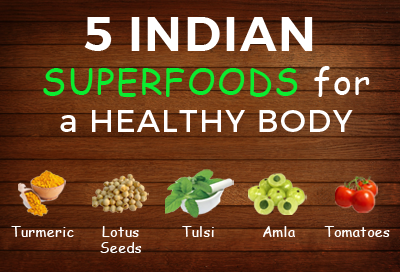
In India, food is a culture! Every single household here attaches tremendous significance to it and Indian food is known across the globe for its lip-smacking taste and great health value.
Food is undoubtedly one of the most critical aspects of our overall health and well-being. Superfood is a term coined by food manufacturers for nutrient-rich (full of antioxidants and vital vitamins) foods that are considered to be particularly useful for making a healthy body.
Here are 5 Indian super foods for a healthy body that have taken the world by storm:
1) Turmeric - Every Indian household’s go-to fix for myriad health problems, turmeric, has lately become the global food trend. This age-old bright yellow-colored spice comes from the ginger family, and is often used as a powder in Indian cooking for coloring and added flavor. Due to its culinary uses and a plethora of health benefits been associated with it, turmeric has been referred to as the most powerful plant on the planet. Turmeric is made up of various compounds, known as curcuminoids. The “super-powers” of turmeric is due to its bioactive component, namely, curcumin, that makes turmeric a functional food. Curcumin has anti-inflammatory and antioxidant properties. It is used to treat cancers, prevent tumors growth, and to boost the overall immune system. Turmeric can be powdered and added to curries, or chopped up and added to a tonic. Furthermore, the anti-inflammatory qualities of turmeric make it an excellent cure for skin disorders like acne. Turmeric face masks greatly help clear up your face from acne breakouts and reduce acne scarring.
2) Lotus Seeds - In India, lotus seeds are mostly found in a dried form called as “Makhana” or gorgon nuts. Puffed up like balls of cotton, lotus seeds are low in fat and sodium and rich in protein, while also being high in mineral content. This superfood is becoming a popular snack in western wholefood shops too. Makhana could be one of the best options for healthy office snacks, thus helping control obesity. They are used in soups, salads, curries and puddings. Lotus seeds, with their low sodium content, are very useful for people suffering from high blood pressure and diabetes. Ayurvedic health practices claim that lotus seeds have astringent properties and contain enzymes that combat kidney related issues and inhibit ageing respectively. With their healthy composition, lotus seeds can be blended with flours and dals, making a low-cost food to overcome malnutrition, prevalent in India.
3) Tulsi - Tulsi or Holy Basil, with its holistic properties, is rightly called as the “queen of herbs”! Due to its uncountable health benefits, it is regarded as the “Golden remedy of Ayurveda” and is used in many ayurvedic medicines. A Tulsi plant is present in every Hindu household, both, for worship and medicinal purposes. The tiny but mighty leaves of Tulsi plant have antibacterial and antiviral properties that help fight infections and completely rid you of inflammation. The anti-inflammatory qualities of Tulsi leaves are sure to help in lower back pain treatment, one of the most common health concerns today. Tulsi is a natural stress-reliever, calming the nerves and promoting relaxation. It prevents ageing and skin damage by helping your body fight against free radicals. Tulsi leaves can be consumed whole, or in juice, paste, and powder forms. An effective home remedy for respiratory disorders, this magical herb also boosts your immunity when consumed as a tea or tonic.
4) Amla (Indian Gooseberry) - A powerful superfood, Amla, is rich in essential vitamins like Vitamins A, B-6 & C, and dietary fibre. This nutrient-rich fruit, grown in several states of India, greatly helps improve immunity and indigestion. It is also beneficial for the hair and skin. Antioxidants present in this wonder fruit play a significant role in the proper functioning of your liver. They help flush out toxins from the liver, thus preventing liver damage. Many liver diseases cause liver pain. The antioxidants found in amla also help reduce inflammation and thus soothe pains in the liver area. Amla can be consumed chopped, boiled, as a juice, as dried slices, in chutneys, pickles, and also can be cooked with other vegetables. It is also widely used in the preparation of hair and skin beauty products. A popular polyherbal, multi-purpose Ayurvedic medicine called Triphala; contains dried Amla fruit as one of its ingredients.
5) Tomatoes - Besides their heavenly juiciness, tomatoes have many more important things to offer. Scientifically speaking, a fruit, but considered as a vegetable by nutritionists, a tomato is rich in alpha and beta carotenes, and essential minerals including Vitamin C. India is one of the major tomato growing countries in the world. Tomatoes are great for the kidney, while also being effective in treating gallbladder stones. Being the major dietary source of the antioxidant lycopene, consuming tomatoes reduces the risks of heart disease and cancer. The redder the tomato, the more lycopene it is known to contain. Tomatoes can be a part of soups, salads, and can be cooked with other vegetables also. They can be eaten whole, stuffed, or even grilled. Tomato puree (a thick liquid prepared by cooking and straining tomatoes) is very commonly used in Indian households to cook various types of curries. What’s more, the powerful antioxidant qualities of tomatoes could be used to tone your face by applying tomato juice.
Author Bio
Jessica Smith is an avid reader who enjoys getting lost in the world of books. Holding on to her passion for fitness, She Believes that a healthy diet is a key to healthy living.